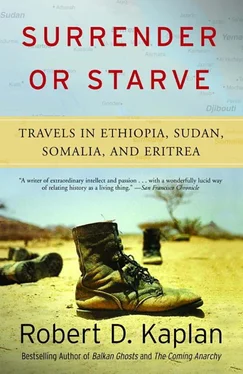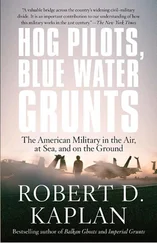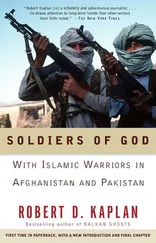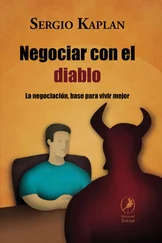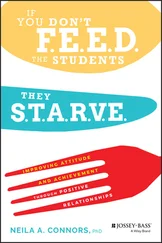There is little free access to the new villages and Government escorts, or “minders,” are ever present. The authorities choose the areas that visitors are allowed to see….
An elderly woman, asked for her views [on villagization], replied at length, her words sounding as though they were steeped in anger. When she finished, the [government] interpreter’s translation was: “I don’t know. I am an ignorant woman.”
I decided to go to Somalia (in October 1986) to hear the refugees’ stories firsthand. It took me a week to get a visa from the Somali Embassy in Nairobi and then to get on to one of the twice-weekly flights to Mogadishu. Once in Mogadishu, the UNHCR office assisted me with the rest of my journey, which included another plane flight to the steamy port of Berbera in the north; from here a UNHCR Land Cruiser drove across the entire width of northern Somalia, first to Hargeisa, where I spent the night, and then, finally, to Tug Wajale, where I slept in a sleeping bag inside a drafty tent on the freezing, windy plateau. The return journey to Nairobi took just as long. Several members of the Nairobi-based foreign press corps also made the journey at one time or another in 1986. But because Tug Wajale, on account of its location, could not be done as a “quickie,” practically no one from outside Africa came in to do the story. (The only exception I am aware of was Philip Revzin of The Wall Street Journal, whose report was published May 26, 1986.) Thus, only a handful of articles appeared about the testimony of the Oromo refugees, and almost all of those were buried on inside pages.
I interviewed fourteen refugees at Tug Wajale B and another nearby camp in three days at the end of October 1986. Almost all of the interviews were done in isolation; the refugee was moved by Land Cruiser to an area out of earshot from his or her compatriots, where I spent, on the average, about ninety minutes talking to the person. The translator I used was not a member of the Oromo Liberation Front or any other political organization I know of, and he had been highly recommended to me by several foreign relief officials. I tried hard to avoid asking leading questions, and I sought constantly to ferret out inconsistencies in the stories I heard, so much so that one of the women I interviewed accused me of being hostile. Despite all of these precautions, I was impressed with the consistency of the accounts. All, interviewed separately, told more or less the same story; the gruesome tale of Fatma Abdullah Ahmed, described at the beginning of this book, was repeated many times during my stay at Tug Wajale. Nothing I heard was substantially different from what Jason Clay or Lance Clark had reported, even though some of the people I interviewed had arrived at different times and were in a different batch of refugees from the ones Clay and Clark interviewed. I was warned that refugees were prone to invent tales of political persecution, so that they will be considered by the U.N. as bona fide “refugees,” instead of just as drought victims, who were liable to be sent back to their country of origin after agricultural conditions improve. But my interviews proved otherwise. These escapees, who had lived in isolated villages, spoke only Oromo, and probably encountered white foreigners for the first time in their lives at Tug Wajale, simply were not sophisticated enough to recognize bureaucratic distinctions that not every relief official could recognize. It simply strained logic to believe that what these refugees were saying was not essentially true. Yet not only did few want to believe them, as in the case of resettlement, few even wanted to listen.
Villagization went on unabated and thereby paved the road to the next famine by uprooting the way of life of the country’s most successful group of farmers. In 1987, foreign donors were helping to make up cereal deficits in twenty-two of thirty-nine regions of Hararghe, which prior to villagization traditionally had registered surpluses. Thus, large amounts of Western aid were subsidizing communism, albeit indirectly, while charities such as Live Aid were serving to buttress a ruling elite that had destroyed the lives of more of its own people than had any other government in this decade, with the sole exception of Iran’s, and that consistently had refused to negotiate a truce in a war that killed hundreds of thousands. Clay’s frequent assertion that Western aid in the long run could kill more people than it saved in the short run was neither farfetched nor unfair.
Meanwhile, partly on account of the uproar raised by the U.S. government and MSF, resettlement ground to a halt in January 1986. But it got rolling again in March 1987. The first mention of this appeared near the bottom of a story on Ethiopia, written by correspondent James Brooke, in The New York Times (March 13, 1987). The article labeled resettlement “controversial.” The New York Times correspondent also noted that the Ethiopian government planned to resettle only thirty thousand people a month, which was half the rate of the 1984–1985 period, thereby indicating perhaps that resettlement would be less “hurriedly executed” and therefore somewhat more humane. If it eventually turns out that resettlement—if not villagization—was truly reformed, then the Reagan administration and a few human rights and relief groups deserve the credit. The media’s overall response to Ethiopian collectivization was remarkably passive.
For a time at least, U.S. journalists were as ubiquitous in Ethiopia as they have been in Nicaragua. But, as Arch Puddington pointed out in Commentary (April 1986), while “the Nicaraguan revolution has been subjected to a microscopic examination,” the one in Ethiopia, which has led to the deaths of many more people, “has been largely ignored.”
The only thing necessary for the triumph of evil is for good men to do nothing.
—Edmund Burke
It was a typical U.S. performance: bighearted, extravagant, and, ultimately, somewhat naïve. Close to forty tons of durra were being anchored onto cables that dangled from three Boeing 107 helicopters, hovering several hundred feet in the air over the Sudanese town of Nyala, 600 miles west of Khartoum in the very center of the African continent. It was late August 1985, and although the drought had broken, the desert of western Sudan had been transformed into a vast arterial watershed by the heaviest rains in more than a decade. Tens of thousands of starving peasants were trapped by floods in the weeks prior to the harvest, and because many airstrips were washed out, the only way to get food in was by costly, fuel-consuming helicopter drops. On this particular day, August 29, the durra was being flown into the savanna region of Buram, one hundred miles south of Nyala, which had gone without grain deliveries for almost three months. On hand to take part was USAID administrator M. Peter McPherson.
The suspended durra moved through the air at a crawl. After an hour and a half of flying, small clusters of wattle huts began appearing amid the flood-soaked, green desert canvas below. Using a VHF radio, a Save the Children Fund field officer guided the pilots toward the drop zone, which we could see was filling up with dark, seminaked figures running in the same direction as our helicopter. McPherson and I already were on the ground when the second and third helicopters released their loads. Had the scene been staged in Hollywood it couldn’t have been more stirring: mobs of barebreasted women, armed with spears, tore into the mountain of grain, fighting over the individual sacks while shrieking “ esh Reagan” (Reagan’s bread). There practically was a riot. Within a minute or two, every sack was gone. McPherson, an old Peace Corps hand, was ecstatic. I still can picture him sweating in his white shirt and exclaiming how happy President Reagan was going to be when he heard about this. McPherson said something to the effect that these people were going to remember what the United States did for them for years to come. Later, in Washington, another USAID official actually described the Buram peasants as new political allies of the United States.
Читать дальше
